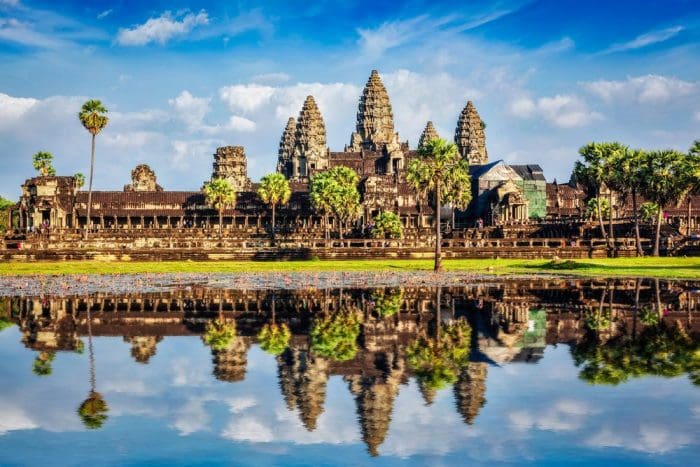Cambodia is one of the most fascinating countries in Southeast Asia, and its Angor Wat temple site is the country’s main tourist attraction and for a good reason; it’s the largest religious monument in the world.
There are many outstanding ancient sites throughout Asia worth visiting, such as the Senso-ji Temple in Tokyo, Japan or Gyeongbokgung Palace in Seoul, South Korea. But Angkor Wat is head and shoulders above the rest, which is why it’s considered one of the Seven Wonders of the World.
Angkor Wat is simply an astonishing place, from an architectural, religious and aesthetic viewpoint; you’ll be left in absolute wonderment at the sheer scale and beauty of the place.
This UNESCO World Heritage site is a must-visit for history enthusiasts, architecture buffs, and anyone seeking a glimpse into the rich cultural heritage of Southeast Asia.
It is a massive 162 hectares in size, meaning you really need to spend more than just one day exploring all there is to see here. The main temple alone is four times bigger than the Vatican, and the entire area takes over a space larger than the whole of Paris.
Day 1: Discovering the Marvels of Angkor Thom
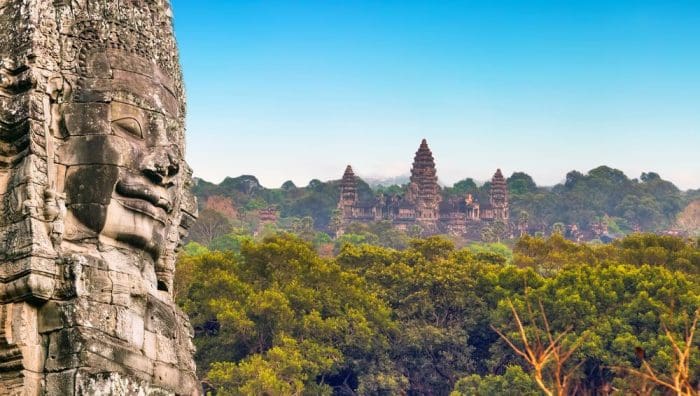
In this two-day itinerary, we’ll guide you through the highlights of Angkor Wat and its surrounding temples, ensuring that you will make the most of your visit. Let’s begin with arriving at Angkor Archaeological Park and why 2 days is the best option for visiting the site.
Buying your ticket at Angkor Archaeological Park
It’s a good idea to arrive early at Angkor Archaeological Park. This is not only to beat the crowds (which can reach up to 2,000 foreign visitors each day), but also to enjoy the site before the hot temperatures start to rise.
Walking around the massive park from one temple to another for 2 days can get pretty exhausting under the hot Cambodian sun, so make sure you bring plenty of water with you to stay dehydrated.
Purchasing your entry pass is straight forward, and it’s best to buy your ticket in person at the park rather than online, which is more expensive.
There are three types of tickets you can purchase at the park; a 1-day pass, a 3-day pass and a 7-day pass. As a special incentive to help get visitors back to the park following covid, each pass includes a bonus day.
So if you purchase a 1-day ticket, then you’ll get to use it for a bonus second day, which is really good value for money at just $37, which would actually cost $59 if you book online.
A lot of people recommend a 3-day pass, which costs $62 at the park, and if you have the time and money then it’s a good option, but you can see the most important temples at the site within 2 days.
Bayon Temple
The unique Bayon Temple is one of the most incredible temples you’ll see in all of Angkor Wat (or anywhere else for that matter) and is a great start for your 2-day itinerary.
It’s quite different aesthetically than the Angkor Wat temple and most of the other temples on the site. Bayon Temple was the latest temple to be built on the site at the end of the 12th Century and was the state temple for King Jayavarman VII.
What make this temple so unique are its 216 smiling stone faces of Avalokiteshvara, which is an important Buddhist deity.
Wandering around all the towering faces and through the labyrinth of galleries to then ascend to the upper terrace for panoramic views of Angkor Thom is quite a surreal but amazing experience.
Baphuon Temple
The next must-see temple on our itinerary is Baphuon Temple, which is a massive three-tiered pyramid temple dedicated to the Hindu god Shiva and is located in Angkor Thom.
Also known as ‘Golden Mountain’, this is another impressive site that was built in the 11th Century before the city of Angkor Thom was established.
It features intricate carvings, and you can climb to the top for stunning vistas of the whole of Angkor Archaeological Park.
Food options near Angkor Wat
You are allowed to bring your own food to the temple site, but there are also several restaurants located close by on the outskirts of the park.
Cambodian food is really very decent, with a focus on curries, seafood and soups and is considered quite similar to Thai cuisine.
‘Amok’ is a tradition coconut fish curry that is served in banana leaves and is considered the national dish of Cambodia, so is definitely a must try dish when visiting the country.
Angkor Café is one of the restaurants situated conveniently near the temples and here you can enjoy a delicious Cambodian meal amidst a serene garden setting.
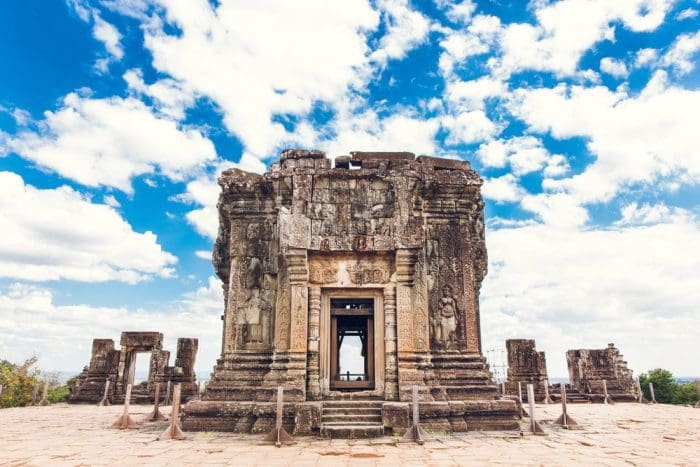
Terrace of the Elephants and Terrace of the Leper King
For the afternoon on our Day 1 itinerary, you can stroll over to the Terrace of the Elephants, an ancient viewing platform adorned with intricate carvings and statues of elephants. It’s a part of the walled city of Angor Thom and another striking historical landmark.
Adjacent is the Terrace of the Leper King, which features detailed carvings of dragons and creatures that refer to Hindu mythology. It has a 7 metre high platform and dates back to the 12th Century.
Preah Khan Temple
Located just under an hour’s walk away from the Terrace of the Leper King (don’t worry, there are plenty of tuk tuk drivers at the site waiting for your service), is Preah Khan Temple.
This is a sprawling temple, which was a former Buddhist monastery. It features labyrinthine passages, corridors and intricately carved stone walls. This was built for King Jayavarman VII in the 12th Century to honour his Father.
Exploring the inner sanctum of the temple and the courtyard area that has numerous shrines and towers is a fascinating experience.

Sunset at Phnom Bakheng
No visit to Angkor Wat is complete without experiencing the sun set. One of the best spots to see this is at the temple Phnom Bakheng. It’s common for crowds of tourists to head to this ideal spot to witness the sun go down over the temple complex.
It offers a spectacular vantage point, as the sun paints the ancient stones in a magnificent golden hue. The temple itself is really interesting too; it was built as early as the 9th century and is dedicated to the Hindu God Shiva.
Day 2: Sunrise at Angkor Wat and Beyond
Sunrise at Angkor Wat
After finishing Day 1 with a sunset, why not witness a majestic sunrise over the iconic Angkor Wat to get Day 2 underway in breathtaking fashion. There’s much debate as to which is better to view at Angkor Wat; sunrise of sunset.
Both are spectacular of course, but sunrise is more inspiring for the day ahead. With the sunset the park closes not long afterwards, which can be a bit of a disappointment and somewhat of an anticlimax.
Arriving before dawn to witness the sunrise is a good idea as you can secure a prime viewing spot, as the first light bathes the temple’s spires in a mesmerizing glow.
Behind the reflecting pool in front of the main temple is the best spot for this and offers dramatic light and colours reflecting from the water. Bring some snacks along in case you get peckish while waiting for the sun to rise.
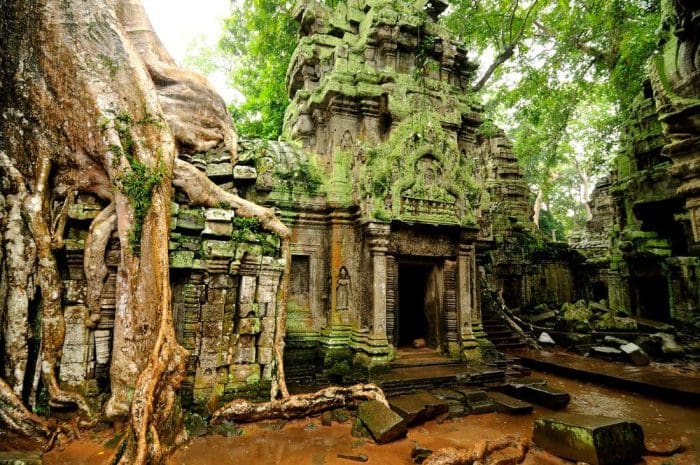
Exploring Angkor Wat
After the majestic sunrise, you can spend the morning exploring the intricacies of the main temple; Angkor Wat. Walking down the main entrance into the temple is an absolutely unforgettable experience in which you feel like you’ve transcended back in time.
Inside the temple you can marvel at the intricate bas-reliefs depicting Hindu epics and ascend to the upper levels for a bird’s-eye view of the whole complex.
Ta Prohm
Situated about a kilometre east from Angor Thom is the hauntingly beautiful Ta Prohm temple, known as the ‘Tomb Raider temple’ because the 2001 movie filmed at the temple.
It’s not hard to see why as well and was also used as a location for the classic movie: ‘Indiana Jones and the Temple of Doom’.
This is one of the most aesthetically memorable temples on the whole site, as it is most famous for its astonishingly massive tree roots that intertwine with the temple’s stone.
The sheer size of the tree trunks makes you feel somewhat tiny in comparison and it’s quite hard to fathom the scale of what you’re seeing.
Lunch at Srah Srang
Translating as: ‘Royal Bath’, Srah Srang is a large, serene reservoir and is the perfect spot for a picnic, so come prepared! You’ll be surrounded by lush greenery and beautiful views and it’s the perfect place to relax.
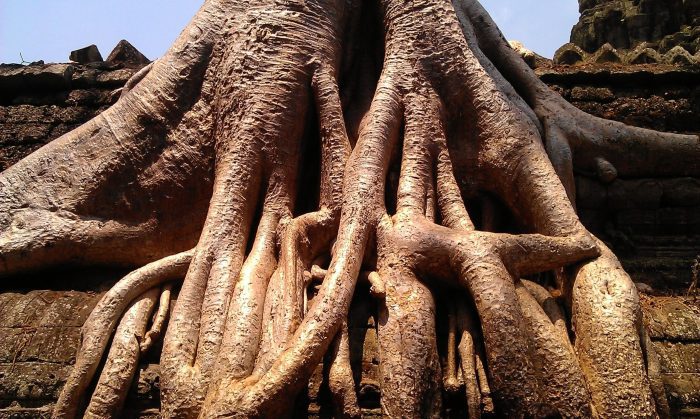
Banteay Srei
After lunch, there is one more temple site that is absolutely worth checking out before the end of your Angkor Wat adventure.
This is Banteay Srei, which is located 25km away from the main set of temples, which may seem far, but this site is simply not to be missed.
The temples here offer exquisitely intricate wall carvings, often considered as some of the most impressive and finest stone carving anywhere in the world.
They may be somewhat small in comparison to all the other temples but are just as impressive. They are known for having unique pinkish sandstone and they are often referred to as the ‘Citadel of the Women’.
Conclusion: 2 Days in Angkor Wat Itinerary
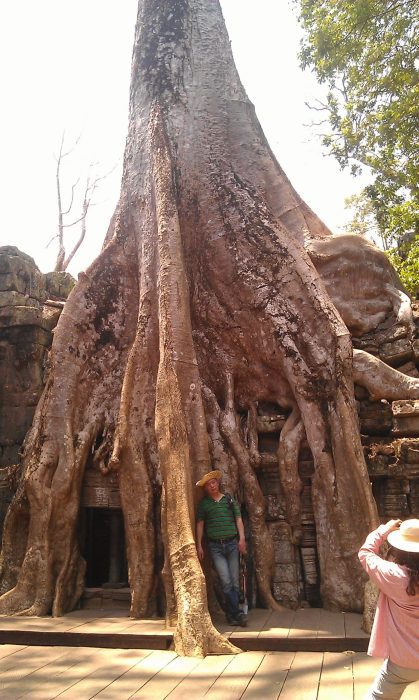
2 days in Angkor Wat is an awe-inspiring couple of days that transports you back to the incredible ancient civilization of the east. It is a journey that’s inspiring, mesmerising and completely unforgettable.
From watching the sunset to seeing the sunrise the following morning, this 2-day itinerary features the best temples to visit at Angkor archaeological park where you can really soak in the mystical ambience of the place that will stay long in the memory.


